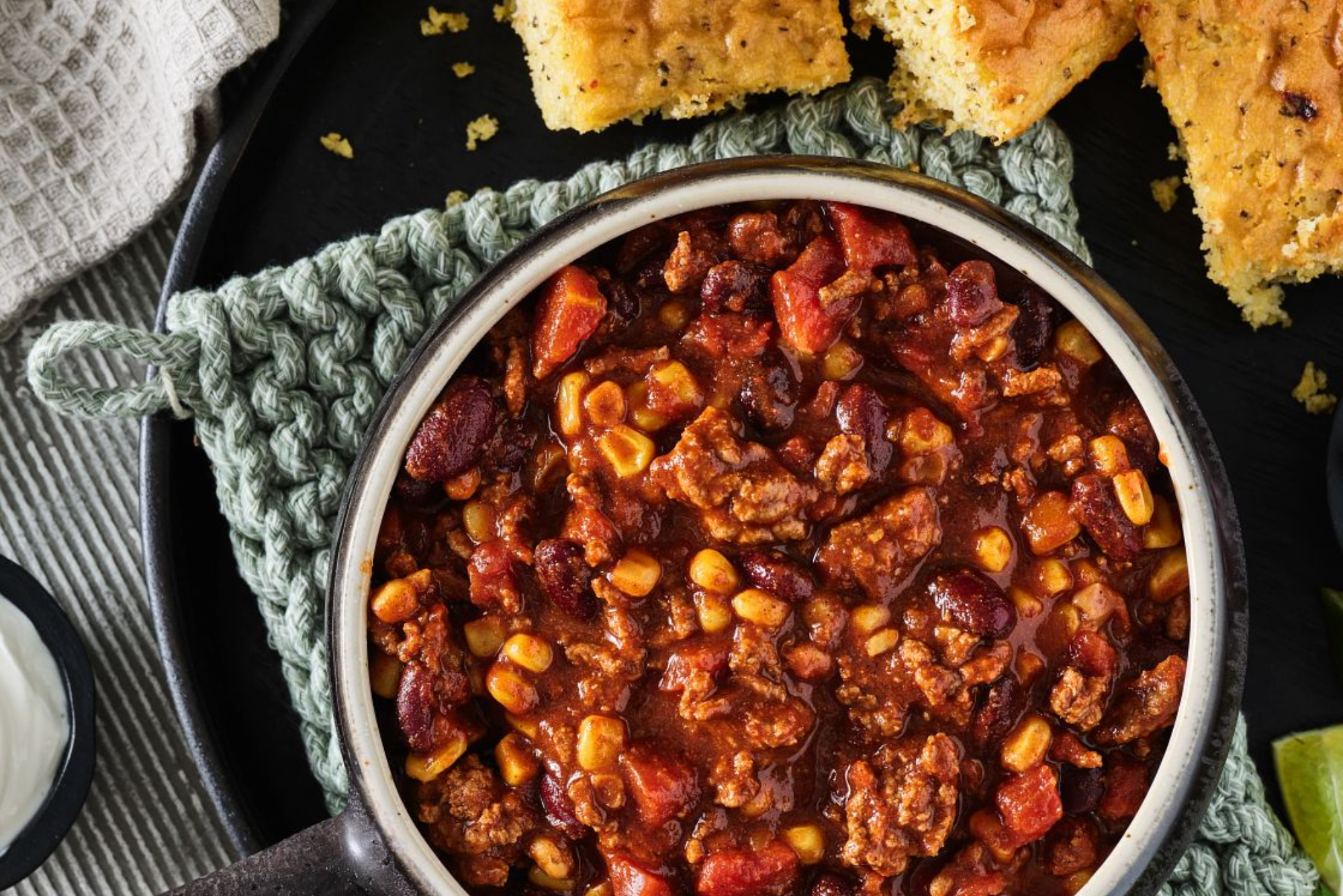Chili Recipe: A Flavorful Comfort Food
Introduction to Chili
Chili is a beloved dish known for its hearty, spicy flavors and comforting warmth. It has deep roots in American and Mexican cuisine, with various regional takes on the recipe. Whether you enjoy a traditional beef chili, a vegetarian version, or a spicy chicken chili, this dish is versatile and can be tailored to suit any palate. Chili has become a favorite for everything from casual family dinners to large gatherings due to its ease of preparation and bold flavors.
Ingredients for the Best Chili Recipe
To make a delicious chili, it’s important to use quality ingredients and strike the right balance between flavors. Below are the essential components for the perfect chili.
Essential Ingredients
- Ground Beef or Alternative Protein: Ground beef is the classic choice for chili, but turkey, pork, or plant-based options can be substituted for different tastes or dietary needs.
- Beans: Commonly used beans include kidney beans, black beans, and pinto beans, which add texture and heartiness.
- Tomatoes: Diced tomatoes, crushed tomatoes, or tomato sauce provide the base for the chili’s sauce.
- Onions, Garlic, and Bell Peppers: These vegetables add depth of flavor and complement the spices.
- Chili Powder and Other Spices: A good chili recipe relies on chili powder, cumin, paprika, and cayenne pepper to deliver its signature flavor.
Optional Ingredients
- Corn and Jalapeños: These can add sweetness and heat to the chili, offering a more complex flavor profile.
- Chocolate and Beer: For an extra layer of richness, dark chocolate and beer can be added to the chili, enhancing its savory notes.
Substitutions for Dietary Preferences
- Vegan and Vegetarian Chili: You can replace the meat with plant-based proteins like tofu, tempeh, or more beans for a fully plant-based version.
- Gluten-Free Chili: Ensure all ingredients, especially the beer, are gluten-free to cater to gluten sensitivities.
Step-by-Step Guide to Making Chili
Making chili is a straightforward process, but following the right steps can take it from average to extraordinary.
Preparing the Ingredients
Begin by dicing your onions, garlic, and bell peppers. If you’re using ground meat, brown it in a large pot over medium heat, then drain any excess fat. If you’re making a vegetarian chili, sauté the vegetables until softened.
Cooking the Chili

Once the meat is browned or the vegetables are sautéed, add your spices. Stir in chili powder, cumin, and cayenne, allowing the flavors to bloom. Then, add your tomatoes and beans, and bring the mixture to a simmer. Reduce the heat and let the chili cook for at least 30 minutes, stirring occasionally.
Finishing Touches
Before serving, taste your chili and adjust the seasonings as needed. If the chili is too thick, add a little water or broth to reach your desired consistency. Let it simmer a little longer to ensure the flavors meld together perfectly.
Tips for the Perfect Chili
While chili is simple to make, there are a few tricks to elevate the dish.
How to Add Depth of Flavor
Adding unusual ingredients like a square of dark chocolate or a splash of beer can enrich the chili’s flavor. These elements create a deeper, more complex taste without overpowering the traditional spices.
Controlling the Heat
Chili’s spiciness is easy to adjust. For a milder version, use less chili powder or swap out jalapeños for bell peppers. To make it spicier, add extra cayenne or fresh chili peppers. To cool down a too-spicy chili, serve it with dairy-based toppings like sour cream or avocado.
Best Cooking Methods
While chili can be made on the stove, you can also use a slow cooker or instant pot for convenience. A slow cooker allows the flavors to develop over time, while an instant pot will speed up the process without sacrificing taste.
Serving Suggestions

Chili is versatile and can be enjoyed in many ways. Here are some ideas to complement your bowl of chili:
Popular Chili Toppings
- Sour Cream: Adds a creamy contrast to the heat of the chili.
- Shredded Cheese: Melted cheese on top of chili creates a rich, satisfying texture.
- Green Onions & Jalapeños: These toppings add a fresh bite and additional heat.
- Tortilla Chips: A crunchy addition that pairs perfectly with the soft beans and meat.
Side Dishes to Pair with Chili
Chili is often served with classic sides like cornbread or rice. For a low-carb option, serve it over cauliflower rice or with a simple side salad.
Creative Leftover Ideas
Chili is just as good the next day. Use leftovers to create chili nachos, chili cheese fries, or stuffed baked potatoes.
Table: Comparison of Chili Types
| Chili Type | Key Ingredients | Spice Level | Cooking Time | Dietary Notes |
|---|---|---|---|---|
| Traditional Beef Chili | Ground beef, beans, tomatoes, spices | Medium to high | 1 hour | Can be made gluten-free |
| Vegetarian Chili | Beans, veggies, tomatoes, spices | Medium | 45 minutes | Vegan, vegetarian, gluten-free |
| White Chicken Chili | Chicken, white beans, green chilies | Mild to medium | 1 hour | Can be made dairy-free |
| Spicy Chili | Ground beef, jalapeños, cayenne | High | 1 hour | Can be made extra spicy |
Frequently Asked Questions (FAQs)
How long can chili be stored?
Chili can be stored in the refrigerator for up to 4 days. It also freezes well and can last up to 3 months in the freezer. To reheat, simply thaw and warm on the stove.
Can I make chili without beans?
Yes, a “beanless chili” or “Texas-style chili” focuses on the meat and spices, omitting beans. This is a popular option for those who prefer a meat-heavy version or follow low-carb diets.
What are the best meats to use in chili?
While ground beef is the classic choice, you can also use ground turkey, pork, or even shredded chicken. For a vegetarian option, plant-based proteins like tempeh or tofu work well.
How can I thicken my chili?
If your chili is too watery, you can thicken it by letting it simmer longer uncovered, mashing some of the beans, or adding a slurry of cornstarch and water.
Can I make chili in a slow cooker?
Absolutely! To make chili in a slow cooker, brown the meat and sauté the vegetables first, then transfer everything to the slow cooker. Cook on low for 6-8 hours or high for 3-4 hours.







